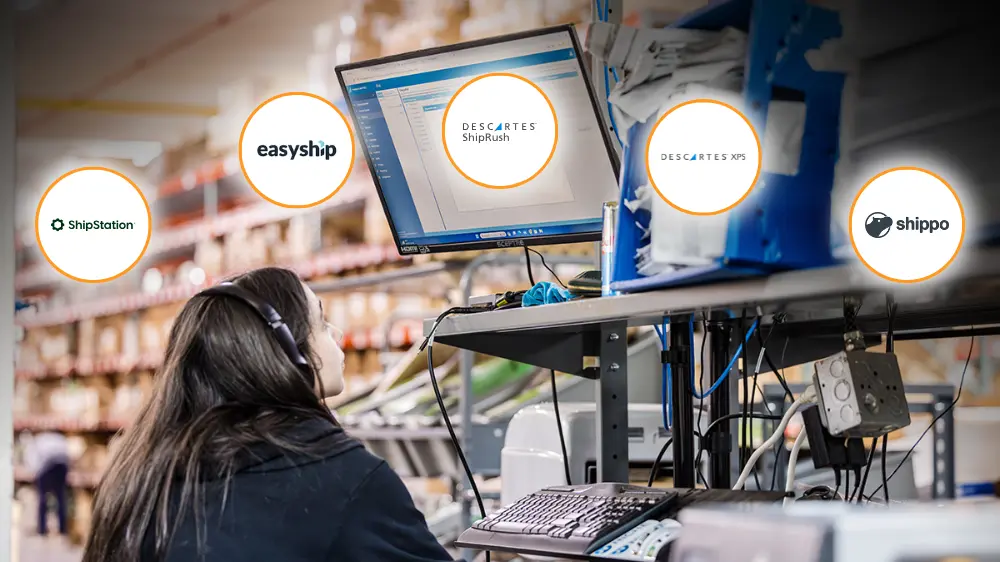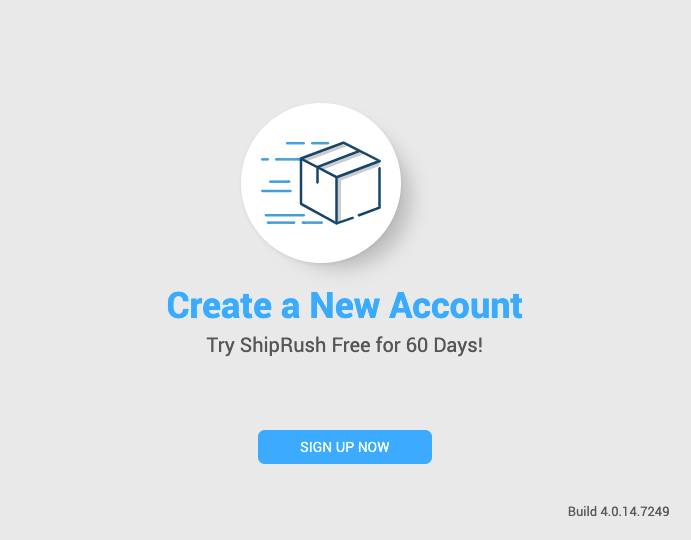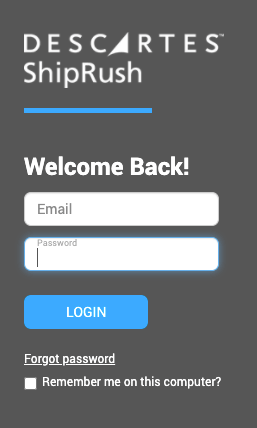
Ecommerce shipping solutions are a dime a dozen, and they all promise two things: discounted shipping rates and a way to ship faster. As a warehouse manager or leader in ecommerce logistics, it can feel exhausting to even think about narrowing down the options to find the best shipping solution for your business. Which one will actually deliver on its promises and make a measurable difference in your warehouse KPIs and bottom line?
For multichannel ecommerce sellers, especially rapidly growing ones, warehouse throughput is the deciding factor when it comes to choosing an ecommerce shipping solution. You need something proven to keep up with spikes in order volume, prevent backlogs at the ship station, and ensure on-time deliveries. Let’s look at the best options to accomplish this.
Table of Contents
- c. Easyship
- d. Shippo
- e. ShipStation
What is warehouse throughput?
Before we dive into solutions, let’s establish a common definition of warehouse throughput. When we’re talking about ecommerce order fulfillment, warehouse throughput is the quantity of units you can move through the warehouse or get out the door per day. It measures the efficiency of warehouse operations and helps warehouse managers identify bottlenecks and ways to reduce operational costs.
5 best shipping solutions to increase warehouse throughput
Warehouse throughput generally becomes a pain point for rapidly-growing ecommerce businesses as order volume and business complexity outpaces logistics. We see this happen to small to mid-sized ecommerce businesses that recently added new sales channels, went viral on social media or TV, or otherwise triggered rapid growth.
With that in mind, we recommend that you evaluate these five shipping solutions when considering how to increase throughput and scale your business:
- Descartes ShipRush
- Descartes XPS Ship
- Easyship
- Shippo
- ShipStation
All five solutions offer the features and scalability necessary for high-growth ecommerce businesses, along with a track record of increasing throughput and warehouse efficiency. Let’s look at what sets each program apart.
Descartes ShipRush

Descartes ShipRush is a robust multi-carrier shipping solution that features deep integration with the rest of the Descartes software ecosystem. It boasts powerful business automation capabilities and multi-carrier rate shopping. However, the big-picture reasons people choose Descartes ShipRush are the ease of use for multichannel shipping and ease of integrations with sales channels (e.g., Amazon, eBay, and Shopify) and NetSuite, according to Capterra.
Pros:
- “Built for NetSuite” SuiteApp for easy NetSuite integration
- Available as a pre-integrated bundle with Descartes WMS systems or all-in-one ecommerce growth platform Descartes Sellercloud
- Customers report cutting processing time from 30 seconds to under 10 seconds
Descartes XPS Ship

Descartes XPS Ship is a quick-to-implement, user-friendly multi-carrier shipping solution with the same dedicated live customer support team as Descartes ShipRush. Shopify sellers love the Descartes XPS Ship Shopify app, and international shippers appreciate the templates for international shipping documents and automatic filing. The main reason customers love Descartes XPS Ship is the ease of use and the excellent customer service, according to GetApp.
Pros:
- Low-cost shipping solution with scalable capabilities at an affordable price; free to start
- Easy way to start international shipping with free live support and user-friendly UI
- Provides real-time shipping rates to customers at checkout for WooCommerce or Shopify
Easyship

Easyship is a powerful yet accessible multi-carrier shipping platform with access to a staggering 550+ global courier services1. Easyship really shines at enterprise international shipping and fulfillment, offering shipping quotes for duties and taxes and its own network of 3PL fulfillment centers around the world. Customers appreciate the platform’s ease of use, customer support, and API integration with 3PL warehouses, according to G2.
Pros:
- Offers enterprise shipping and a global shipping API for maximum reach
- Provides a free international duties and taxes calculator anyone can use
- One global shipping account for every country and carrier
Shippo
Shippo is a multi-carrier shipping software provider that focuses on three main groups: small businesses, developers, and 3PLs/ecommerce platforms2. This solution features shipping API architecture and an intentionally developer-friendly experience. With API documentation and support, Shippo provides the resources to help developers easily establish connectivity. Shippo customers appreciate the platform’s ease of use, according to G2.
Pros:
- Dedicated cybersecurity team, data encryption, 24×7 monitoring and SOC2 Type 2 audits needed for enterprise shipping
- Address validation and address parsing with addresses API
- Reduce WISMO tickets with shipment tracking API
ShipStation

ShipStation is a shipping software platform that also includes some inventory and order management capabilities. ShipStation integrates with 180+ sales channels, carriers, and other programs in Australia, France, Germany, United Kingdom, New Zealand, Canada, and the United States3. Customers praise ShipStation’s ease of use and sales channel integrations, especially WooCommerce, according to TrustPilot and G2.
Pros:
- Extensive network of integrations for connection to existing programs
- Has deepest shipping rate discounts for FedEx, up to 90% off4
- Reporting and analytics for sales, customers, and operations
Warehouse throughput FAQs

Why does warehouse throughput matter?
Warehouse throughput matters because if you can’t increase your throughput to keep pace with income order volume, you’ll build up a backlog of customers waiting for orders to be fulfilled. You risk compromising your delivery promise if you can’t keep up with orders and fulfill them on time.
When backlogs happen, you have two choices: allow your customers to be upset and receive their orders late or pay more per shipment to increase the delivery speed via a faster and more expense service to get the order delivered on time. Either way, it hurts your business. Increasing warehouse throughput prevents these problems by keeping orders moving.
What variables affect warehouse throughput?
Warehouse throughput is an equation with fixed and variable parts. The fixed part is usually time, measured in working hours per day. The variables are factors that can increase or decrease to affect throughput every day, such as:
- Quantity of incoming orders
- Number of warehouse employees on duty
- Walking time per order for pickers
- How many decisions workers must make to fulfill each order, e.g., service selection
- Amount of time it takes to complete a task, e.g., create and print a shipping label
- Number of errors, e.g., mis-picks and mis-ships that must be corrected
- Amount of time it takes to locate the correct item in the warehouse
- Number of out-of-stock items that delay order completion
- How many times workers must manually enter data into different programs
The better you can control these variables, the more you can increase throughput and overall warehouse efficiency.
Which warehouse KPIs measure throughput?
There are many naming conventions and ways to measure warehouse KPIs. Here are a few formulas and descriptions that help managers evaluate warehouse throughput:
- Total throughput = # of items dispatched / day
- Measures overall warehouse efficiency
- Employee throughput = # of items dispatched / day / employee
- Helps managers set goals for productivity and hold employees accountable
- Pick throughput = # of orders picked / day
- Helps managers identify problems with picking operations
- Pack throughput = # of orders packed / day
- Helps managers identify problems with packing operations
- Ship throughput = # of orders shipped / day
- Helps managers identify problems with shipping processes
These can also break down to hourly key performance indicators such as employee pick rate (# items picked / hour / employee).
Some warehouse management systems and shipping solutions display these data in a dashboard format for warehouse managers’ quick reference. Here’s an example:
How does shipping software increase throughput?
To understand how an ecommerce shipping solution increases throughput, let’s look at the typical bottlenecks in the shipping process and how software can help prevent them.
Eliminates double data entry in the warehouse
Many multichannel ecommerce warehouses use multiple logistics software programs, such as an inventory management system, order management system, ERP, warehouse management system, returns management system, catalog management system, ecommerce platform or marketplaces, and shipping software.
Unless these programs are integrated for seamless data transfer, workers must manually transfer data, such as shipping addresses, tracking information, shipment status, and inventory counts, between programs. This is an error-prone time waster and often causes a bottleneck at the shipping station on busy days.
The solution:
Multi-carrier shipping software integrates with all your sales channels and carrier accounts to seamlessly transfer data from program to program, eliminating double data entry, errors, and wasted time.

“We simply scan the package, and it prints out the shipping label without causing extra delays by needing to jump to a third-party site.”
Grant Kiefaber, Special Projects, State and Liberty Clothing Co.
See how State & Liberty Clothing Co. solved this problem
Prevents mis-ships caused by human errors
Manual data entry and paper-based processes are problems that lead to mis-ships. Let’s face it—humans make mistakes—especially busy humans swamped with orders during peak season. Key entry errors, invalid addresses, and incorrect service selection all lead to mis-ships and late orders.
Mis-ships affect throughput because your warehouse team must spend time assisting unhappy customers and re-processing old orders instead of fulfilling new orders. Imagine how much more productive your team would be if they didn’t have to deal with mis-ships anymore.
The solution:
Shipping software eliminates manual data entry and uses address validation technology to prevent shipping errors. You can even automate service selection and other potentially error-prone processes. It’s even better when integrated with a warehouse management system for a seamless, error-free pick-pack-ship process.

“Mis-ships are a monster cost. If you mis-ship a $2,000, 85 lb. item, it ends up costing an average of $400. As you can imagine, that adds up quickly. Based on our Q4 trend of improving picking and shipping accuracy with Descartes Peoplevox WMS and the Descartes ShipRush shipping solution, we expect to reduce mis-ships to less than 1% of all orders [this year], saving an estimated $50,000.”
Colin M. Kelly, Managing Director, Big Frog Supply
See how Big Frog Supply solved this problem
Automates service selection and other decisions
To ship orders correctly and on time, warehouse workers typically must make multiple decisions throughout the shipping process. What size and type of package should I use? Which carrier? Which service level will get the order there on time and meet all my customer’s delivery requirements? Does this order need proof of delivery or any other special services? What about shipping insurance?
All these decisions take time and expertise if a human is making them for every order. Plus, relying on a warehouse worker to make these decisions leaves room for human error, which contributes to mis-ships and more wasted time.
The solution:
You can automate these decisions with a multi-carrier shipping solution by building if/then business rules. This way, you can automate tedious, repetitive tasks, prevent errors, and free up your human resources for more productive activities.

“Now we’re able to handle extreme daily shipping volumes and meet customer expectations without missing a beat or having to triple our warehouse staff like in the past, while simultaneously keeping shipping costs in check.”
Jason Lewin, CMO, American Paper Optics
See how American Paper Optics solved this problem
Prints shipping labels faster
Printing shipping labels is another bottleneck we often see in the shipping process. Small businesses typically start by printing labels one at a time, manually keying in the address and shipment information to generate a shipping label. That process isn’t fast enough for multichannel sellers and rapidly-growing businesses.
As order volume increases, packages quickly pile up at the shipping station if you try to print labels individually. This can cause you to miss your carrier pickup deadline because shipments aren’t ready to go on time.
The solution:
Create and print shipping labels in bulk using ecommerce shipping software. It integrates with all your sales channels so you can create shipping labels for all your orders in one place. You can even set the program to automatically enter shipment information and print labels.

“I regularly had to drive packages to the FedEx depot to make sure orders ended up in customers’ hands on time—not a productive use of my time. We were shocked at how simple it was to radically transform our shipping process and eliminate a huge headache in our daily workflow.”
Traci Bruton, VP of Sales at eCard Systems
See how eCard Systems solved this problem
Which features in an ecommerce shipping solution matter for throughput?
The reality is that not all ecommerce shipping solutions are built alike. Though most of them offer the same discount shipping rate programs and basic features, shipping platforms can vary greatly in terms of usability, scalability, automation, integration with other programs, customer support, and other important factors.
Here are the most important features and capabilities your ecommerce shipping solution needs for maximum throughput:
- Integrations with all your existing sales channels and carriers
- WMS integration for a seamless pick-pack-ship process
- ERP integration if you use NetSuite or a similar system
- Automation rules to handle tedious, repetitive tasks
- Barcode scanning for the warehouse to eliminate paper processes
- 24/7 customer support to provide help and peace of mind as you grow
- Bulk label creation/edits and batch printing
- Generate pick tickets (only if no WMS is used) and packing lists
- Print shipping labels with customizable DOC tabs
- Templates for international shipping documentation (if needed)
- Tagging, sorting, and grouping orders by different criteria
How much does the Descartes shipping software for this cost?
Descartes ShipRush pricing and Descartes XPS Ship pricing for shipping software ranges from free to $9.95-99.95 per month, depending on the plan5. Custom pricing is also available for enterprise accounts.
Key Takeaways
- Problems with warehouse throughput, including outdated fulfillment and shipping practices, get in the way of business growth. Technology helps you solve them.
- The top five shipping software programs to increase throughput include Descartes ShipRush, Descartes XPS Ship, Easyship, Shippo, and ShipStation.
- Pair multi-carrier shipping software with a warehouse management system or all-in-one ecommerce growth platform for maximum throughput.

About the Author
Mikel Richardson is a General Manager at Descartes, the global leader in providing on-demand, software-as-a-service solutions focused on improving the productivity, performance and security of logistics-intensive businesses. As GM of the ecommerce division, Mikel helps ecommerce brands grow wherever they are in their journey, whether shipping their first order or scaling internationally.
References
- Retrieved from https://easyship.com/ on January 15, 2025.
- Retrieved from https://shippo.com/ on January 15, 2025.
- Retrieved from https://shipstation.com/ on January 15, 2025.
- Retrieved from https://www.shipstation.com/discounted-rates/ on January 16, 2025.
- Retrieved from https://shiprush.com/pricing and https://xpsship.com/pricing on January 20, 2025.









